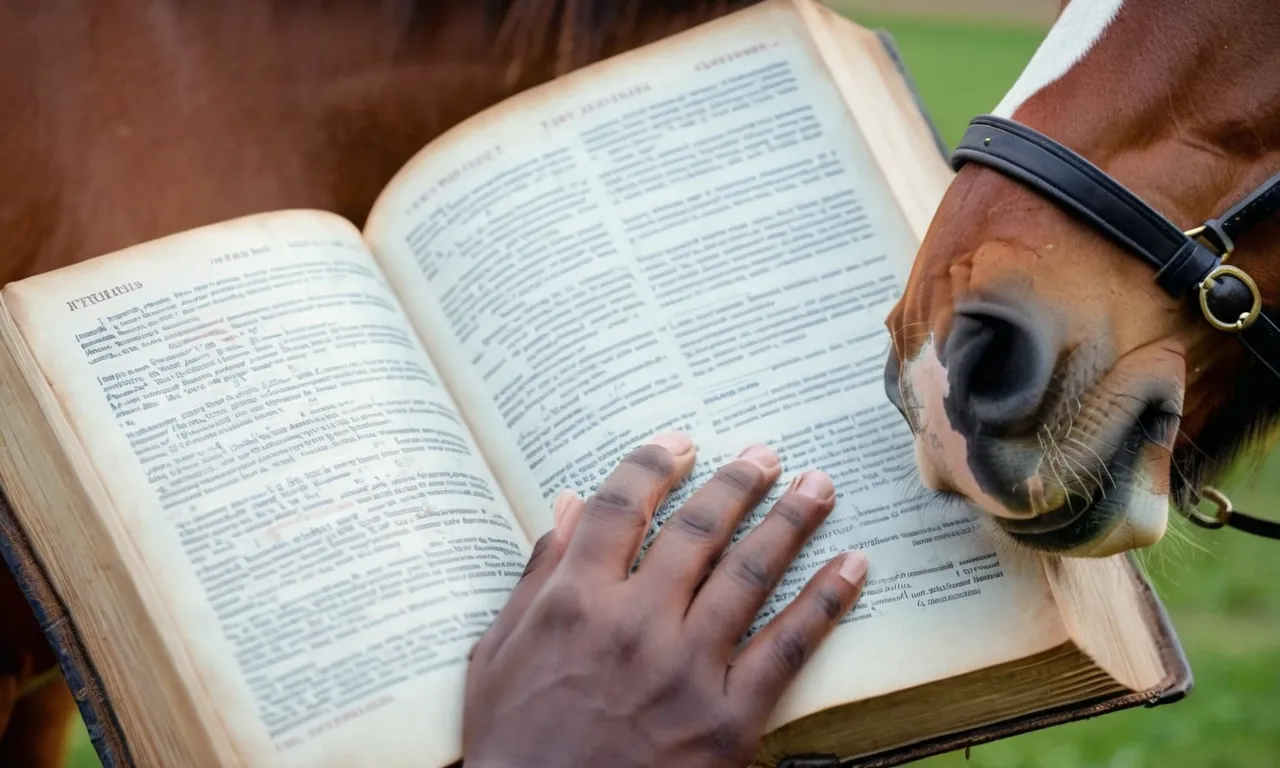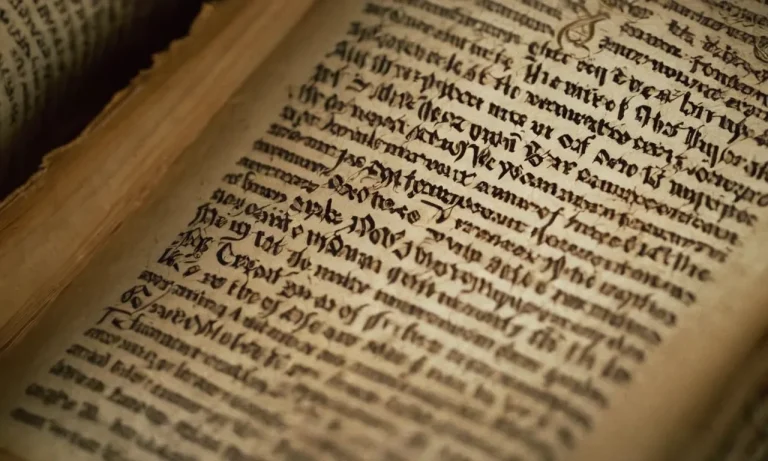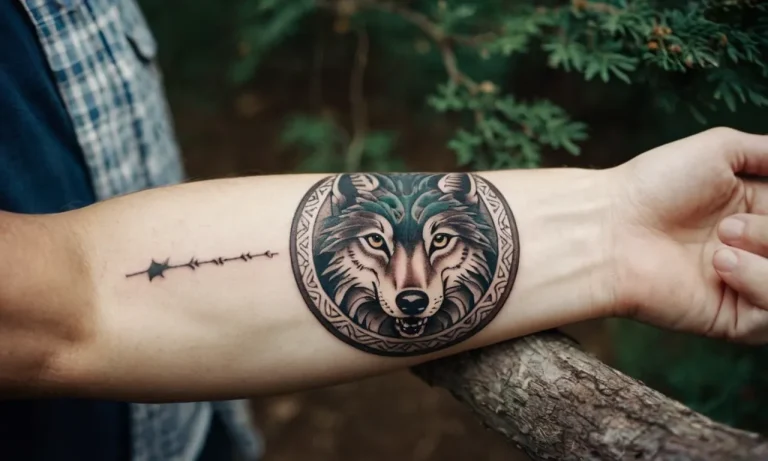What Does The Bible Say About Horses?
Horses are mentioned many times throughout the Bible, from references to chariots and cavalry in battle to metaphors and parables featuring horses. If you’re short on time, here’s a quick answer: The Bible views horses primarily as symbols of strength and instruments of war, but also occasionally as representations of vanity and intense desire.
Now let’s dive deeper into the full biblical context surrounding horses.
In this comprehensive article, we will explore numerous Scripture passages that reference horses, analyzing what these verses reveal about the symbolic and practical role of horses in biblical times. We will survey how horses were utilized in warfare and transport, examine metaphorical usages of horses, and synthesize key themes and takeaways regarding the spiritual and cultural significance of horses in the Bible.
Horses as Instruments of War in the Bible
Horses and Chariots in Battle
Horses and chariots were pivotal to warfare tactics in Biblical times. Kings and armies utilized the speed and strength of horses to overwhelm enemies on the battlefield. Chariots offered mobility and devastating shock value when charging enemy formations.
The Bible first mentions horses in relation to Egypt, where chariotry formed the cutting edge of Pharaoh’s military force (Exodus 14:9). However, the Israelites under Joshua later defeated a coalition of Canaanite kings utilizing chariots (Joshua 11:4-9).
This showed that chariots were not invincible, especially when countered by determined infantry and terrain advantages.
King David incorporated chariots into Israel’s army, inflicting decisive defeats against the Philistines (2 Samuel 8:4). His son Solomon imported horses from Egypt and Kue, building chariot cities to house the new arm of Israel’s military (1 Kings 9:19; 10:26-29).
Later Judean kings such as Asa and Jehoshaphat maintained large chariot forces for defense (2 Chronicles 14:9; 17:14–19).
The prophets also mention cavalry—mounted warriors fighting from horseback with bows or spears. Jeremiah 4:29 describes an impending invasion: “The whole city flees because of the horsemen and archers.” Here, cavalry and chariots exemplify the enemy’s speed of attack.
Cavalry and National Security Concerns
The Bible prohibition against multiplying horses appears primarily in Deuteronomy 17:16-17, where Moses warns future kings not to establish large cavalry forces, which he said would: “cause the people to return to Egypt in order to multiply horses.”
This warning against amassing weapons was due to national security concerns. First, importing large numbers of horses required intense international trade, mainly with Egypt. Moses likely wanted to reduce Israel’s dependency on Egypt’s resources.
Second, fielding cavalry and chariots necessitated complex infrastructure to house, feed, and service them. This concentrated wealth and power around the monarchy in a way that made the people vulnerable to oppression.
As expected, multiplying horses became a marker of kingly excess and military ambitions. King Solomon’s stupendous horse trade brought this warning to pass (1 Kings 10:26-29). Later, the Northern Kingdom fell in part because its rulers “multiplied horses” (Hosea 1:7).
This established the horse trade as symbolic of national calamity.
Metaphorical Usages of Horses in Scripture
Symbol of Strength
In the Bible, horses are often used as a symbol of strength and power. Some examples include:
- The book of Job speaks of God giving strength to the horse (Job 39:19) and comparing the horse’s power to a leaping locust (Job 39:20). This illustrates how the horse is seen as a mighty and powerful creature.
- The book of Psalms declares that God takes no delight in the strength of the horse (Psalm 147:10). Here the psalmist uses the horse’s strength as a metaphor for human power and might which is meaningless apart from God.
- Proverbs 21:31 states, “The horse is prepared for the day of battle, but victory rests with the Lord.” This conveys both the horse’s readiness and fitness for war as well as the understanding that true victory comes not from military power but from God’s providence.
So in these passages, the horse epitomizes vitality, vigor, and physical power. But the Bible authors also make clear that while horses represent impressive earthly strength, true might and triumph come only from the Almighty Creator.
As such, the horse was a fitting symbol of worldly energy and prowess, while also reminding God’s people to rely fully on divine power rather than temporal strength.
Representation of Vanity and Intense Desire
In other contexts, the Bible employs horse imagery to symbolize human vanity, folly, and unchecked craving. For example:
- Ecclesiastes 1:8 poetically speaks of man never being satisfied, using a horse galloping back to its starting point to represent fruitless toil and unfulfilled desire.
- Psalm 20:7 contrasts trusting in chariots and horses (instruments of war and power) with faith in God’s supernatural protection.
- Isaiah 31:1,3 warns against going down to Egypt for military aid which would be trusting in “horses” and “chariots” over God’s enablement.
So the horse could symbolize self-sufficiency versus reliance on God, ambition without godly contentment, instant gratification instead of patience hope, and earthly vanities over eternal priorities. The strength and vigor which horses represent – while impressive in a temporal sense – can reflect misplaced confidence and selfish pursuits when separated from faith and virtue.
Interestingly, according to research, references to literal horses in the Bible number around 150 times, while figurative mentions of horses tally approximately 80 times. This shows how frequently biblical writers utilized the horse as a meaningful metaphor for conveying spiritual truths – both positive and negative.
So whether seen as an emblem of vitality and heroism or an illustration of vainglory and moral danger, the metaphorical horse gives color and resonance to many scriptural passages, making abstract concepts relatable and memorable.
The biblical authors skillfully employed this symbolism through poetry, prophecy, and apocalyptic writings to underscore spiritual lessons for God’s people down through history.Practical Roles and Cultural Significance
Horses for Transport and Labor
Throughout history, horses have played an instrumental role in transportation and labor. Before the invention of automobiles and machinery, horses were relied upon to carry people, pull wagons, plow fields, and much more. Their strength and speed made them perfectly suited for these practical tasks.
For thousands of years, horses were the primary mode of land transportation. Riding horses allowed people to travel greater distances than they could on foot. Horses pulled stagecoaches, wagons, and carriages, transporting both people and goods across cities and countries.
The Pony Express used horses to swiftly carry mail over 2000 miles across the American frontier in the 1860s.
On farms, horses plowed fields, hauled crops, pumped water from wells, and powered grinding mills. Their ability to pull heavy loads made farming more efficient. Even in cities, horse-drawn taxis and delivery wagons were common sights before cars took over.
Horses were such an essential part of everyday life and work.
Today, while horses are no longer widely used for transportation and farm labor, they still play important practical roles. Police departments use horses for crowd control and patrolling city streets. Ranchers and farmers still rely on horses to move livestock and maintain their land.
And horses are invaluable partners for many with disabilities, providing mobility and assistance.
Status Symbols for Kings and Nobles
In addition to their practicality, horses became status symbols associated with power and prestige. Owning quality horses was a mark of nobility and wealth. Kings and aristocrats had elaborately outfitted horses to flaunt their elite standing.
In the medieval era, knights and samurai rode large, strong warhorses into battle. Fierce and intimidating, these horses displayed their rider’s military might and dominance. Artwork from the Middle Ages often depicted kings and nobles posed heroically on horseback.
Horses with rare colors or special breeds were prized in many cultures. For instance, the Akhal-Teke horse, with its metallic sheen, was valued by royalty in ancient Persia. Arabian horses were treasured for their beauty, spirit, and stamina.
In Europe, pure white horses were traditionally reserved for royalty.
Owning fine horses and being a skilled rider gave nobles an advantage in battle, sport, and transportation. As a result, only wealthy elites could afford the upkeep for these luxurious creatures. Commoners relied on more basic workhorses. This created a clear social divide enforced by horses.
Even into modern times, horse ownership and equestrian activities remain associated with affluence and status. Racehorses can sell for millions of dollars. Many equestrian sports like polo, jumping, and dressage require substantial investments in training and facilities.
Though they no longer dominate transportation, horses continue to be cultural symbols of power, prestige, and nobility across societies. Their history is deeply intertwined with human society’s development and class structures.
Key Themes and Takeaways
The Bible contains many references to horses, highlighting their importance in ancient societies. Here are some key themes and takeaways regarding what the Bible says about horses:
Horses Symbolized Strength and Prestige
Owning horses often signified wealth and status. Kings and warriors rode horses into battle (Exodus 14:9, Jeremiah 51:21). The horse’s strength and speed made it useful for war, transportation, and agriculture.
Horses were prized possessions, though the Bible warns against trusting in them over God (Psalm 20:7, Psalm 33:17).
God Cares for Horses
Despite being possessions, Scripture shows God cares for the wellbeing of horses. He gives them strength (Psalm 147:10), sets their life spans (Job 39:19-25), and cares when they suffer (Proverbs 12:10). This reflects how God values all of His creation.
Imagery of Judgment and Salvation
Horses feature metaphorically in passages concerning judgment and salvation. References to horses often symbolized God waging war and justly judging nations (Jeremiah 4:13, Habakkuk 3:8). But the Bible also uses horses to depict salvation and restoration, with Jesus entering Jerusalem on a colt (Zechariah 9:9) and riding a white horse at His return (Revelation 19:11).
Cautions Against Excessive Trust in Horses
Though valuable, the Bible warns against putting too much confidence in horses and chariots for military strength over trusting in God (Deuteronomy 17:16, Psalm 20:7). Israel was forbidden from multiplying horses because they can promote greed and divert dependence on God (Deuteronomy 17:16).
Conclusion
In summary, Scripture depicts horses as formidable instruments of warfare, as creatures representing vigor and self-reliance apart from God, and more neutrally as beasts of burden and markers of wealth and power.
While the Bible recognizes their impressive capabilities, the predominant emphasis is on reminding readers that true strength and salvation come only from the Lord, not merely from material provisions.
This exploration of horses throughout the Old and New Testaments provides deeper insight into how this animal was intertwined with ancient Hebrew culture and worldview. Whether charging into battle or laboring in the field, the horse surfaces repeatedly as a multi-faceted symbol within the biblical drama, underscoring themes of divine providence and the temptation of earthly pride.
Hopefully this overview illuminates why horses loomed so large within the scriptural record and imagination.








